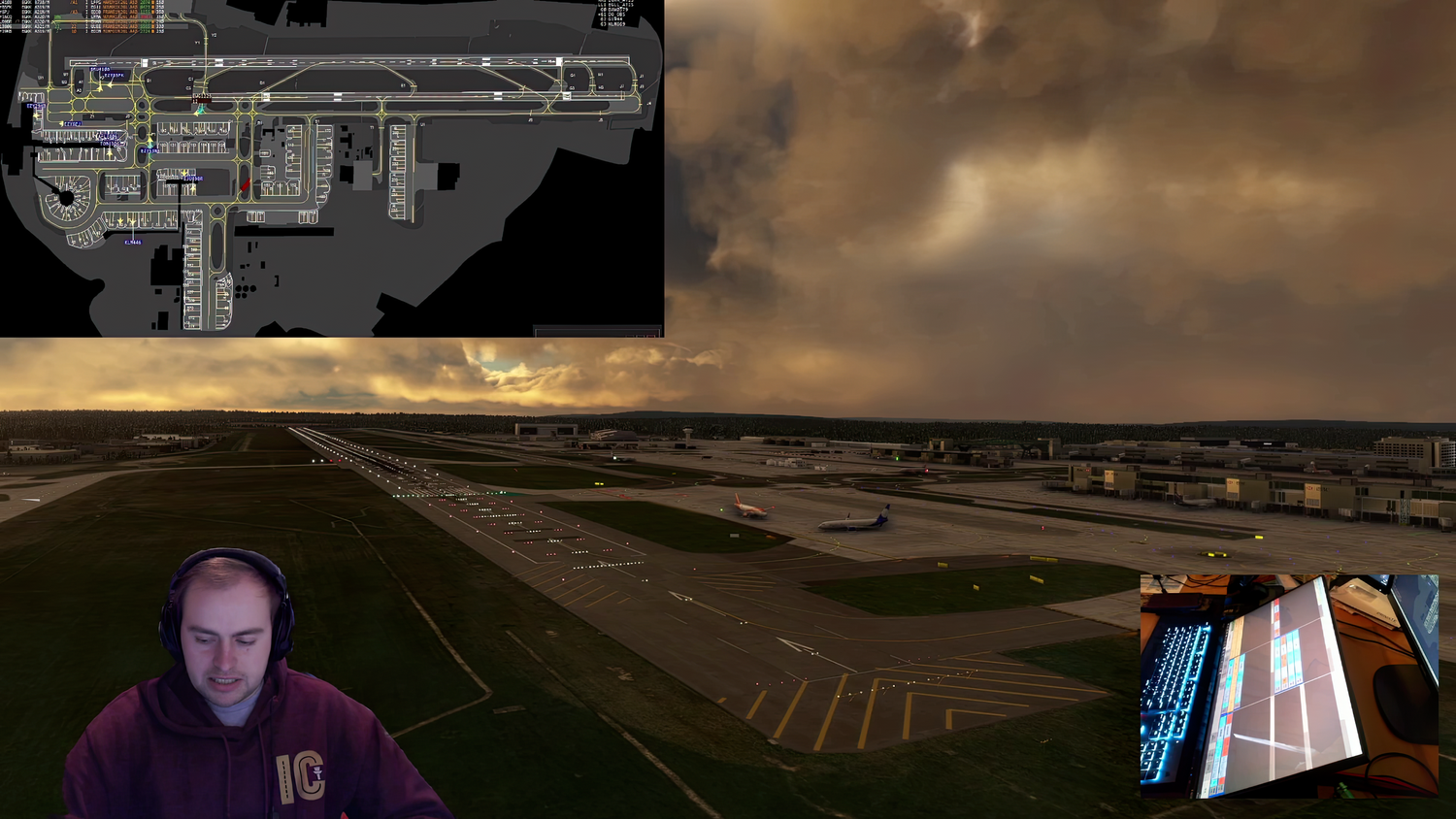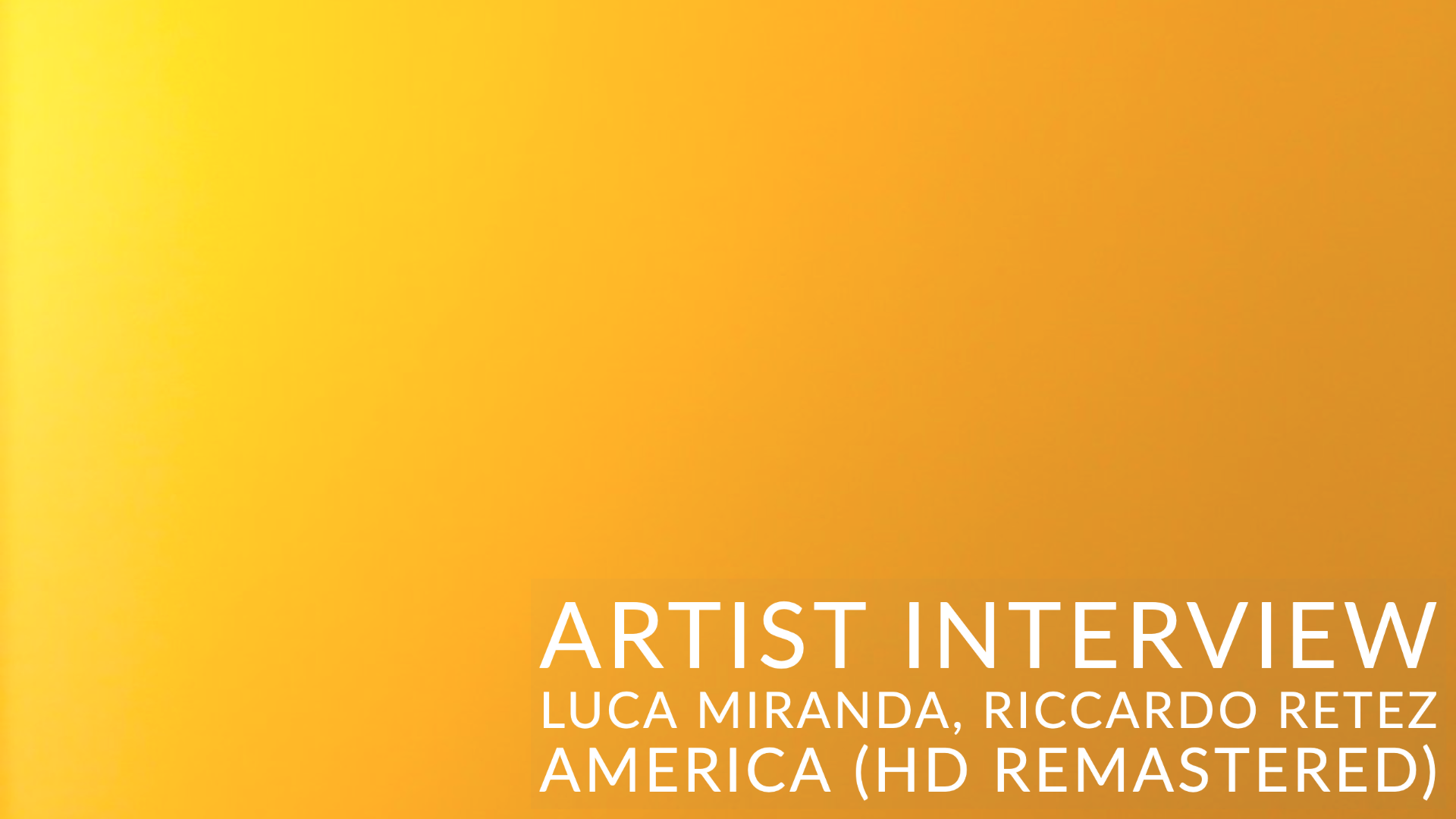In this short video, Luca Miranda, artist, writer, and curator, celebrates the 50th VRAL show.
ARTICLE: VOLARE: MICROSOFT FLIGHT SIMULATOR MACHINIMA IS TAKING OFF
Patreon-exclusive content
〰️
Patreon-exclusive content 〰️
Shortly after the release of Microsoft Flight Simulator (2022), a remarkable amount of experimental, avant-garde machinima landed in the White Cube. Three, in particular, stand out: The Cool Couple’s Flyin’ High, Luca Miranda & Riccardo Retez’ America (HD Remastered) and Sebastian Schmieg’s Lights will guide you home.
First screened at the 2021 Milan Machinima Festival, America (HD Remastered) is a sui generis adaptation/replay of America (1986), Jean Baudrillard’s philosophical travelogue. Upping the ante re: the so-called “crisis of the real” denounced by Guy Debord in his 1967 treatise, The Society of the Spectacle, Baudrillard famously argued that reality itself has disappeared: it is no longer a mere representation because simulation took over and basically ate the world. After a series of provocative essays and books including Symbolic Exchange and Death (1976), Seduction (1979), Simulacra and Simulation (1981), Baudrillard wrote a groundbreaking non-academic book titled America (1986), entirely devoted to the land of simulacra. Thirty five years after its publication, this instant cult still provides illuminating insights into the unconscious of a puzzling country, ever so close to imploding or exploding, depending on the point of view. America is a road (and plane) trip across the “New World of banalities”: on America’s freeways, malls, deserts, and cities, Baudrillard experienced an overwhelming, ecstatic emptiness. In his account, the desert is the central metaphor of American culture: empty, vast, radiant, and completely indifferent to history, knowledge, and culture. In short, America chronicles the desert of the real. To reenact Baudrillard’s journey, Mirand and Retez appropriated Microsoft Flight Simulator, a game that uses algorithms and accurate datasets to reproduce the landscape of the United States. They flew over Los Angeles which Baudrillard describes as “an incandescent immensity, stretching as far as the eye can see”. America (HD Remastered’s stunning vistas of Los Angeles are directly lifted from a virtual plane. The video is accompanied by Baudrillard’s original words read by a text-to-speech software tool in French.
Matteo Bittanti
This is a Patreon exclusive article. To read the full text consider joining our Patreon community.
NEWS: MMF MMXXII DISPATCH #5
Hello everyone,
My name is Matteo Bittanti and I am the artistic director of the Milan Machinima Festival, which showcases game-based video art at the end of the end of history.
On behalf of the entire curatorial staff, I am happy to reveal additional details about the fifth edition, which takes place between March 21st and 27th 2022.
The Milan Machinima Festival - a non-profit project that was born at IULM University in Milan - is made possible by the contribution of several people. In this dispatch, I’d like to share some details about our curatorial staff. Specifically, I would like to introduce three key curators: Gemma Fantacci, Luca Miranda, and Riccardo Retez.
Gemma Fantacci is a Doctoral candidate in Visual and Media Studies at IULM University. Her research focuses on the relationship between counter-gaming practices and the avant-garde. She holds an MA in Arts, Markets and Cultural Heritage from IULM, and an MA in Game Design from the same institution. She is interested in machinima, in-game photography and the visual arts. Gemma is the Communication Manager of the Milan Machinima Festival and co-curator of VRAL.
Among her most recent publications is VRAL SEASON ONE published by Concrete Press, which she co-edited with Matteo Bittanti. Introduced in April 2020 amidst a global pandemic, VRAL is a uniquely curated game video experience, offering screenings of machinima created by artists and filmmakers whose work lies at the intersection of video art, cinema, animation, and gaming. The book collects all Season One’s interviews (i.e., exhibitions 01 to 21), including extra content previously released online. The second volume in the series will be released in the upcoming months
Luca Miranda is an artist and independent researcher. His scholarly practice focuses on the relationship between reality and simulation. He is especially interested in the notion of the avatar as an aesthetic entity. Luca is interested in the logic of game mechanics and notions such as immersion, identification, and interpassivity. He received a Master of Arts in TV, Cinema and New Media at IULM University, Milan, and previously a B.A. in Media and Art from the University of Bologna. In 2018, he co-founded Eremo, an artistic collective based in Milan operating at the intersection of video game, sound art, performance and contemporary art. His most recent publication is titled GIOCARE A CAMMINARE (Walking as a game) which focuses on the walking simulator, a video game genre that has emerged in the last decade in the context of the so-called indie scene. The book examines the origins, development, and influence of this genre sui generis within the field of digital gaming. Additionally, the author compares the aesthetics, mechanics, and ways of playing the walking simulator with several works and artistic practice, suggesting that the two have much in common.
Born and raised in Florence, Riccardo Retez received a Master's Degree in Television, Cinema and New Media from the IULM University in Milan in 2019 and a Degree in Graphic Design and Multimedia from the Free Academy of Fine Arts in Florence in 2017. Passionate about cinema, video games and visual culture, Riccardo has produced several short films and video clips. He is the author of MACHINIMA VERNACOLARE (Vernacular Machinima), the first academic study of the Rockstar Editor, a popular video editing software embedded in Grand Theft Auto V (2013). The author describes the dynamics of production, consumption and distribution of machinima within the fandom community, which now represent an increasingly complex media ecosystem.
This year, Gemma, Luca and Riccardo are each curating a special program that will be exclusively screened on March 26 at the MIC, the Museum of Interactive Cinema in Milan. Tickets are still available on EventBrite although seats are limited.
For more information about the Milan Machinima Festival please visit the official website.
Stay tuned for more and thank you for your attention.
NEWS: THREE CURATORS SHARE THEIR VIEWS ON THE MMF MMXXI
Gemma Fantacci, Luca Miranda, and Riccardo Retez — part of the Festival’s curatorial team — discuss the key themes and trends of the MMXXI edition and the rationale behind their programming. (Interview in Italian without subtitles)
IN ITALIAN
Gemma Fantacci is the curator of HACKTHECUBE, an exhibition platform that uses both the format and the problem-solving nature of the Rubik’s Cube. She received an M.A. in Arts, Markets and Cultural Heritage from IULM University and later enrolled in the Master of Arts in Game Design, combining her interest for art with new media, especially video games, machinima, and in-game photography. She is a regular contributor to ATP DIARY, an online magazine focusing on contemporary art. She is also the Communication Manager of the MILAN MACHINIMA FESTIVAL and co-curator of VRAL, an online platform exclusively dedicated to avantgarde machinima. A Ph.D candidate in Visual and Media Studies at IULM University, Gemma Fantacci lives and works in Milan.
Luca Miranda’s practice focuses on the relationship between reality and simulation. He is especially interested in the notion of the avatar as an aesthetic entity and its representational features. In his work, Miranda critically scrutinizes game mechanics and notions such as immersion, identification, and interpassivity. His work deals with the image of the avatar in contemporary culture. Miranda received a Master of Arts in TV, Cinema and New Media at IULM University, Milan, and previously a B.A. in Media and Art from the University of Bologna.
Riccardo Retez is a Doctorate candidate in the Visual and Media Studies program at IULM University, Milan, Italy. He is also a digital content creator specializing in contemporary visual culture including cultural studies and game studies. He is the author of Machinima Vernacolare (Concrete Press, 2020), the first academic study of the Rockstar Editor, a video editing software embedded in Grand Theft Auto V. He is currently studying live streaming culture.
Gemma Fantacci, Luca Miranda e Riccardo Retez — parte integrante del team curatorial del Festival — discutono i temi e i trend dell’edizione MMXXI e condividono alcuni criteri di selezione (intervista in italiano).
Gemma Fantacci è la curatrice di HACKTHECUBE, piattaforma espositiva che adotta la struttura e la logica del rompicapo del cubo di Rubik. Dopo aver conseguito una Laurea Magistrale in Arti, Patrimoni e Mercati presso l’Università IULM, nel 2018 ha ricevuto un Master of Arts in Game nel medesimo ateneo, coniugando l’interesse per l’arte con quello per i nuovi media, e in particolare per video games, machinima e game photography. Collabora regolarmente con ATP DIARY, magazine online di arte contemporanea, è la Communication Manager del Machinima Film Festival e co-curatore del progetto VRAL. Dottoranda nel Programma di Visual e Media Studies dell’Università IULM di Milano, Gemma vive e lavora a Milano.
Luca Miranda studia la relazione tra realtà e simulazione, l’avatar come entità estetica e le correlate dimensioni testuali e visive. Centrale, nella sua pratica artistica, è l’analisi delle meccaniche videoludiche, insieme alla riflessione critica sui concetti di immersione, identificazione ed interpassività. Investiga la figura dell’avatar nella cultura contemporanea. Ha conseguito una Laurea Magistrale in Televisione, Cinema e New Media presso l’Università IULM di Milano e una Laurea Triennale al D.A.M.S. dell’Università di Bologna.
Riccardo Retez è un dottorando in Visual e Media Studies presso l’Università IULM di Milano. Creatore di contenuti digitali che investigano la cultura visiva contemporanea, Retez si interessa di cultural studies e di game studies. È l’autore di Machinima vernacolare (Concrete Press, 2020), il primo studio accademico del Rockstar Editor, un software di montaggio presente in Grand Theft Auto V. Studia le culture del live streaming online.
NEWS: ON THE RED EYE WITH LUCA MIRANDA, RICCARDO RETEZ, AND JEAN BAUDRILLARD
In Luca Miranda and Riccardo Retez’ America (HD Remastered), French philosopher Jean Baudrillard returns to life as a zombie hologram. His simulacrum is on a red eye to an hyper-real Los Angeles. Part of THE CLASSICAL ELEMENTS, a series of five special screenings at this year’s festival, America (HD Remastered) is a remix/remake/reenactment/adaptation of Baudrillard’s fascinating travelogue of the same title (almost). The only machinima created with Microsoft Flight Simulator in this year’s line-up, America (HD Remastered) pushes the boundaries of the medium.
In this video interview (in Italian without subtitles), Luca Miranda and Riccardo Retez - who are also part of the curatorial team - discuss their work. Both Miranda and Luca graduated from IULM University. Miranda’s Cheatimerism was featured in 2020 as part of VRAL, while The Bowl (La Jatte) and Alma were screening at the 2020 and 2019 MILAN MACHINIMA FESTIVAL respectively.
Luca Miranda’s practice focuses on the relationship between reality and simulation. He is especially interested in the notion of the avatar as an aesthetic entity and its representational features. In his work, Miranda critically scrutinizes game mechanics and notions such as immersion, identification, and interpassivity. His work deals with the image of the avatar in contemporary culture. Miranda received a Master of Arts in TV, Cinema and New Media at IULM University, Milan, and previously a B.A. in Media and Art from the University of Bologna.
Riccardo Retez is a PhD.D candidate in the Visual and Media Studies program at IULM University, Milan, Italy. He is also a digital content creator specializing in contemporary visual culture including cultural studies and game studies. He is the author of Machinima Vernacolare (Concrete Press, 2020), the first academic study of Grand Theft Auto V’ video editing software Rockstar Editor. He is currently researching live streaming culture.
In America (HD Remastered) di Luca Miranda e Riccardo Retez, Jean Baudrillard rivive come un ologramma zombie. Il suo simulacro è in volo su una Los Angeles iper-reale. Parte di THE CLASSICAL ELEMENTS, una serie di cinque proiezioni speciali, America (HD Remastered) è un remix/remake/rievocazione/adattamento dell’affascinante diario di viaggio del filosofo francese pubblicato negli anni Ottanta. Unico machinima creato con Microsoft Flight Simulator nella rassegna di quest’anno, America (HD Remastered) ridefinisce la natura stessa e il potenziale espressivo del machinima. In questa video intervista, Luca Miranda e Riccardo Retez — che fanno anche parte del team curatoriale — discutono la loro collaborazione e prassi artistica. Miranda che Luca si sono entrambi laureati presso l'Università IULM. L’opera Cheatimerism di Miranda è stata presentata nel 2020 nell’ambito di VRAL, mentre — un altro remake sui generis — The Bowl (La Jatte) e Alma sono stati proiettati rispettivamente al MILAN MACHINIMA FESTIVAL 2020 e 2019.
La ricerca artistica di Luca Miranda si concentra sulla relazione tra realtà e simulazione, l’avatar come entità estetica e le correlate dimensioni testuali e visive. Centrale, nella sua pratica, è l’analisi delle meccaniche videoludiche, insieme alla riflessione critica sui concetti di immersione, identificazione ed interpassività. Investiga la figura dell’avatar nella cultura contemporanea. Ha conseguito una Laurea Magistrale in Televisione, Cinema e New Media presso l’Università IULM di Milano e una Laurea Triennale al D.A.M.S. dell’Università di Bologna.
Riccardo Retez è un dottorando in Visual e Media Studies presso l’Università IULM di Milano. Creatore di contenuti digitali che investigano la cultura visiva contemporanea, Retez si interessa di cultural studies e di game studies. È l’autore di Machinima vernacolare (Concrete Press, 2020), il primo studio accademico del Rockstar Editor, un software di montaggio presente in Grand Theft Auto V. Studia le culture del live streaming online.
EVENT: VRAL #13_LUCA MIRANDA (NOVEMBER 13 - NOVEMBER 26 2020)
CHEATIMERISM
Digital video (1920 x 1080), color, sound, 14’ 55’’, 2020 (Italy)
Created by Luca Miranda
Introduced by Matteo Bittanti
By reconfiguring the spaces of Grand Theft Auto V, Cheatimerism investigates the political and economic implications of consumption and its side effects, including concrete waste, virtual surrogacy, and planned obsolescence. This machinima shows various sculptural forms made of identical vehicles, the Rapid GT, a sports car, and a waste collection truck, the Trashmaster. Capitalism, the artist seems to suggest, is the ultimate cheat mode.
Luca Miranda’s practice focuses on the relationship between reality and simulation. He is especially interested in the aesthetic potential of the avatar. In his work, Miranda critically investigates game mechanics and concepts such as immersion, identification, and interpassivity. Miranda received a B.A. in Media and Art from the University of Bologna and in 2019 received a M.A. in TV, Cinema and New Media at IULM University. In 2018, he co-founded Eremo, an artistic collective based in Milan. He is currently working on book about walking simulators.
WATCH NOW
Media coverage: Matteo Lupetti, ArtTribune (in Italian)
NEWS: A CLOSER LOOK AT CHEATIMERISM
Luca Miranda’s Cheatimerism will be on display on VRAL until November 26 2020. Miranda is a young Italian artist whose practice focuses on the relationship between reality and simulation. He is especially interested in the notion of the avatar as an aesthetic entity and its representational features. In his work, Miranda actively questions game mechanics and concepts such as immersion, identification, and interpassivity. Two of his works, Alma and The Bowl (La jatte), have been presented at the MILAN MACHINIMA FESTIVAL in 2019 and 2020 respectively. Recently Miranda completed a project titled UNDERW[H]E(A)RE by “photographing” the private parts of more than one hundred virtual characters in Ubisoft’s Assassin’s Creed: Unity (2014), in a style reminiscent of the upskirting pornographic genre, which Urban Dictionary (currently) defines as
A relatively new practice where someone (usually a pervy guy) takes pictures up a girls skirt unbeknownst to her using his mobile phone or camera. There’s a theory that it’s the act of taking the picture whilst the victim is unaware that gives the photographer the thrill, and not in fact the poor quality photograph it results in.
The full project is available here.
We are happy to present UNDERW[H]E(A)RE in machinima form:
Luca Miranda, UNDERW[H]E(A)RE, digital video (1920 x 1080), color, sound, 8’ 33”, 2020.
Below is a short interview with Miranda about UNDERW[H]E(A)RE.
Matteo Bittanti: The fetish is a recurrent trope in your work. In Cheatimerism, cars are the fetishized object of desire, whereas in UNDERW[H]E(A)RE, it’s the female body that is being objectified by the video game camera for the pleasure of a (presumably) male gamer. What kind of gaze is at play in these two projects?
Luca Miranda: Fetishization, abuse, and replication are crucial aspects in my work and they inform my relationship to video games. In fact, I believe that digital game worlds are governed by the fetish: the player forgets the nature of the object itself - which can be a non player character, a 3D model of an object, the level design - only to assign his or her own definition of value. But this is true up to a certain point. I prefer to use the notion of factish coined by Bruno Latour (note 1). According to Latour, there is no need to recognize that there is a fundamental separation between the product and the manufacturer, the object and the subject, because this gap is always filled by the displacement that the product creates on the manufacturer. In other words, we are always superseded by the very goods that we produce. And this also applies to the gaze, which is shaped by the technology that we use and that shapes us as well. A perfect example is the relationship between the streamer, the viewer, the video game (as a product) and technologies of vision. This creates a sort of paradox in which the viewer (including technology, which can interpret our expressions and analyze our feelings) is always watched. We have not strayed far from August Furhmann’s Kaiserpanorama. In both Cheatimerism and UNDERW[H]E(A)RE what is at stake is two kinds of gaze strongly rooted both in visual culture and in the video game experience, that is, the gaze of the possessor and the gaze of the dominator. I do not use these terms to exclusively refer to a coercive use of the act of looking. In fact, the act and the will to possess and dominate can exist even where overt violence cannot be identified. In the case of Cheatimerism, the observer’s gaze coincides with that of non player characters (NPC) “living” in San Andreas. This makes explicit the kind of relationship that we have with the consumer products we abuse. Maybe some passerby may wonder about the mountain of cars, but in the end there are always two possible outcomes: either the NPC ignores it or gets stuck between the collateral damage of the free market. Even the gamer’s gaze is often entangled in the rhetorical networks of which he or she is not aware or to which can contribute by maintaining the status quo. As for UNDERW[H]E(A)RE, here we are dealing with a peep-show dynamic. The camera (which operates as the user’s eye) is situated at a specific level with respect to the gaze of the virtual population. The interesting thing about female non player characters in UNDERW[H]E(A)RE is the fact that what matters is not what is seen by the camera – the petticoat itself never changes – but just the fact that the player can see by using the camera.
Matteo Bittanti: UNDERW[H]E(A)RE is an “intimate” exploration of the dessous of more than one hundred virtual characters of Assassin’s Creed: Unity. What I find fascinating about your project – a visual taxonomy of digital petticoats – is that it clearly demonstrates that class exists even where it should be invisible or even non existent altogether. Only the private parts of aristocratic characters are simulated in detail, whereas those of the lower class are generic, nondescript, thus erotically unappealing. So, rather than being the great equalizer – a visual democratizer – video games seem to reinforce real life inequalities. What is the role of games in shaping the collective imaginary?
Luca Miranda: Exactly. In Assassin's Creed: Unity you can only see the underwear of aristocratic female characters – at least as far as clothing is concerned. But what matters, again, is not the undergarment itself and what it conceals. As I mentioned before, what really matters is being able to see that specific piece of garment. Such a possibility is symptomatic of a certain tendency in video game design. That is, the obscene, pornographic elements of the game exists to satisfy a tendentially masculine gaze. This is a dominant feature of commercial video games. These games may offer an extreme degree of customization and selection of the ethnicity of one’s character, but it is precisely just that…customization. Video game characters – in mainstream gaming, as well as many independent titles – often reflect a militaristic, patriotic and belligerent type. In the case of female NPCs in UNDERW[H]E(A)RE their only purpose is to be watched. A player may well not do so throughout the game, but the possibility is there. All you have to do is get under the “right” woman’s skirt. As you mentioned, if you situate the the camera under the clothes of less aristocratic female models you can't see anything but a void. This is not just a technical issue. There are in fact a series of tensions underlying the culture of video games that serve as operational models for the collective imaginary. In an age marked by cultural, ethnic, social, and economic disparities, the strength of monopolistic capitalism and uncritical homologation have become more manifest than ever. The representative forms of video games are symptomatic of the functioning of the entertainment industry and the complex videogame ecosystem as a whole. There is a concealment of fundamental mechanisms and manipulation of tastes, ideas and ideals, both conscious and unconscious.
Matteo Bittanti: Video games and pornography rely on similar aesthetic imperatives – the excess, the grotesque, the obscene – and produce similar pleasures. They’re both performative and mechanical, even methodical in their execution. They also teach us what to desire and how to desire. How does UNDERW[H]E(A)RE address the proximity of the visual regimes? How does machinima bridge the gap between the viewer and the simulated reality?
Luca Miranda: The relationship between pornography and video games is stronger than it may appear at first, both from a purely aesthetic point of view and in relation to an affective and ideological perspective. Think about the figure of Bowsette in late 2018 or Fortnite as the second most searched term on Pornhub in 2017. These may seem tangential affinities, but I believe that they reveal a lot about the mechanisms of pleasure and desire endemic to virtual worlds. The pornographic excess and the pain-pleasure nexus that can be found in the videogame experience are conjoined in a recursive loop; so much so that we reach a point where it is difficult to separate the concept of freedom of fruition from that of pornographic (visual, tactile, multisensory) consumption. The commercial video game stimulates the famous Lacanian enjoyment that Žižek summarizes with the consumerist imperative “Enjoy!”. The incessant tasks that video games require from the players – missions, side quests, DLCs, extra content, etc. – are increasing. Their function is to keep that loop hidden, the continuous recycling of the same mechanisms and rhetoric. As far as UNDERW[H]E(A)RE is concerned, it does not so much want to address a discourse towards the predominant visual regime of contemporary entertainment as to make itself the visual regime through which video games teach us how, what and how much to desire. Because of its non interactive nature, machinima can provide critical detachment, showing the contradictions inherent in our narratives and tools and opening a dialogue towards these issues.
Matteo Bittanti: Your work contains multitudes. The very title of your work alludes to a space, a time, and a material good, thus evoking the very nature of digital games, which simultaneously are product and a situated experience, a temporal practice, and a technological device. What kind of agency does the player have in this relationship? And how does that differ from the artist’s?
Luca Miranda: Digital worlds can open up multiple dimensions simultaneously. Unfortunately, there is a tendency to use catchy phrases like “today we are all gamers” to justify things like gamification. Such a term, generally related to marketing and social management, obfuscates the real nature of game culture. Despite the incessant marketing about unrestrained freedom within the virtual space it seems obvious that the role of the player is becoming more and more passive. Interactivity has been replaced by interpassive dynamics. There is a fundamental difference between the artist and the consumer. Both are users, but the artist engages with a game in a creative way. He assumes a critical attitude towards a work while the consumer wears himself out in the game by moving away from a real awareness of the work that he or she is performing in order to play. In this sense, the artist is not an elitist type, quite the opposite: the consumer can become an artist if he or she starts to play for real, that is, by appropriating and subverting the game. This is the kind of play performed by modders, Game Artists, and youtubers who break the codes of the game to reveal their “invisible structures”. Even cheaters in a certain sense can be called artists.
Notes
1 See Bruno Latour. Il culto moderno dei fatticci, Milano, Meltemi, 2017, pp. 31-32.
NEWS: GAME VIDEO ESSAY A (MARCH 09 2020)
GAME VIDEO ESSAY A features a series of documentaries made with video game engines that apply the video essay format to machinima. This program, which debuted in 2019, returns to Milan with six original contributions made by eight international artists, on themes ranging from ecology to simulated battles, from virtual desertion to the creation of possible worlds. Two unclassifiable works complete this selection: a sui generis remake of a seminal film/slideshow by Chris Marker and a philosophical bodybuilding session in Los Santos.
GAME VIDEO ESSAY A propone una selezione di documentari realizzati attraverso videogiochi che applicano al machinima il formato del video essay. La formula, già sperimentata nel 2019, ritorna con sei contributi originali realizzati da otto artisti internazionali, su temi che spaziano dall’ecologia alle battaglie simulate, dalla diserzione virtuale alla creazione di mondi. Completano la selezione due opere inclassificabile: un remake sui generis di un seminale film/slideshow di Chris Marker e una sessione di bodybuilding filosofico in quel di Los Santos.
TRAILER
LINE-UP/PROGRAMMA
machinima/digital video, color, sound, 13’ 23”, 2019. Sweden.
machinima/digital video, color, sound, 23’ 39”, 2019. United Kingdom.
Jona Kleinlein, HIDDEN CONFLICTS
machinima/digital video, color, sound, 25’ 08”, 2019. Germany.
Luca Miranda, THE BOWL (LA JATTE)
machinima/digital video, color, sound, 05’ 34”, 2018. Italy.
José Neto, LUGAR COMUM - THE GENESIS OF A DIGITAL WORLD
machinima/digital video, color, sound, 8’ 59”, 2019. Brazil.
Total Refusal, HOW TO DISAPPEAR: DESERTING BATTLEFIELD
machinima/digital video, color, sound, 20’ 06”, 2019. Austria.














![Luca Miranda, UNDERW[H]E(A)RE, Game photography, 100 screenshot, 3840 x 2160 (original resolution).](https://images.squarespace-cdn.com/content/v1/5a92a15fcef372c749ca0487/1605221192174-1SMTL6DMGX0BU68Y92R4/miranda+luca)

